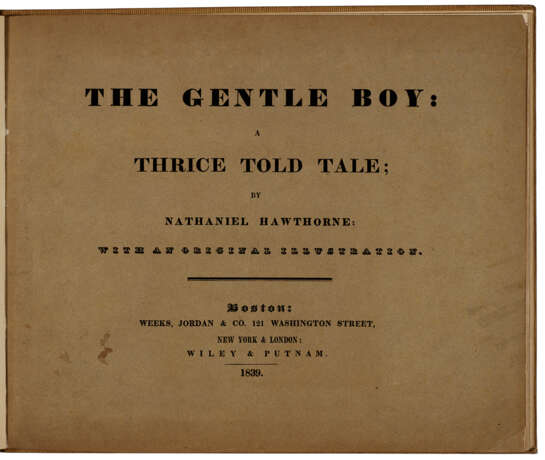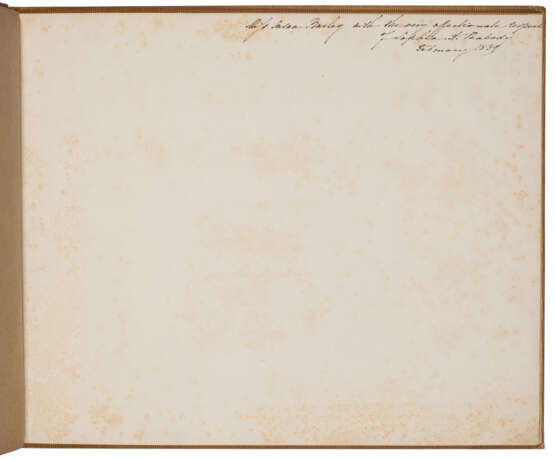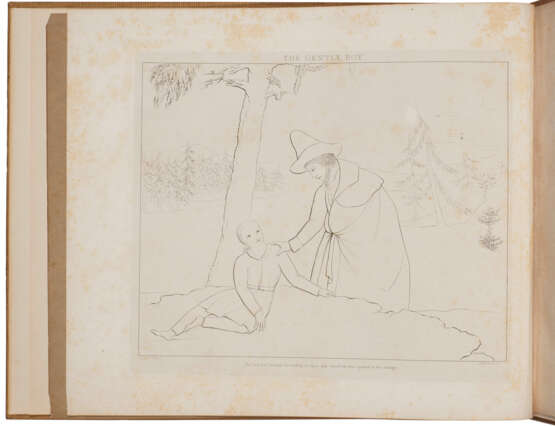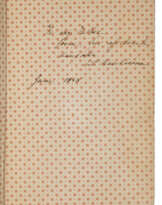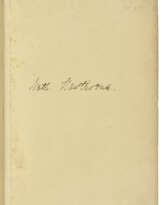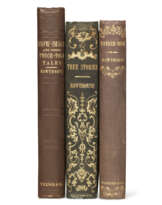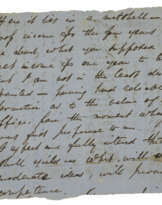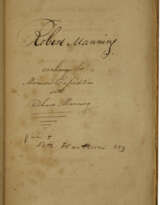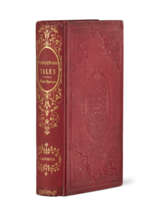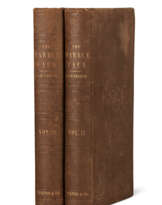ID 967534
Lot 77 | The Gentle Boy, inscribed by Sophia Peabody Hawthorne
Valeur estimée
$ 5 000 – 7 000
Nathaniel Hawthorne, 1839
HAWTHORNE, Nathaniel (1804-1864) and Sophia Peabody HAWTHORNE (1809-1871), illustrator. The Gentle Boy: A Twice Told Tale. Boston: Weeks, Jordan & Co., 1839.
A presentation copy of the first edition, first state, inscribed by Sophia Peabody to her benefactor: "Miss Susan Burley with the very affectionate respect of Sophia Peabody February 1839." Burley had known the Peabody sisters in Salem since their childhood, buying one of Sophia’s illustrated baskets in 1833, and hosting Saturday evening gatherings in 1838 and 1839 to which the Peabody sisters—and sometimes Nathaniel Hawthorne—had come. The tale-writer himself referred to the weekly party as the “Hurley-Burley” (CE 15:316, 486), comically alluding to the opening of Macbeth.
“The Gentle Boy,” a moving tale of the Puritan persecution of the Quakers—inspired by William Sewel’s History of the Quakers and informed by Hawthorne’s own ancestor William Hathorne’s culpability—appeared in The Token in 1831 and, in revised form, in Twice-Told Tales in 1837. The latter version, now “A Thrice-Told Tale,” is complemented by the engraving of Sophia’s image of the Gentle Boy with the Puritan, the cost of which was borne by Susan Burley. The wealthy benefactor believed in the work, speaking in late 1838 of “Mr. Hawthorne’s highest merit—The highest merit of any writer—the unconscious but complete anatomy of the soul—as discoverable in The Gentle Boy” (Ronda, Letters of Elizabeth Palmer Peabody, 221).
Hawthorne dedicated the booklet to Sophia (CE 9:52) and wrote in his preface, “Whatever of beauty and of pathos he had conceived, but could not shadow forth in language, had been caught and embodied in the few and simple lines of this sketch” (CE 15:568). But Sophia did not like the initial engraving by Joseph Andrews (CE 9:566-67), and the image was retouched. Susan Burley recognized Hawthorne’s gift early on, referring to his writing as a “golden web” (Julian Hawthorne, Nathaniel Hawthorne and His Wife, 1:167); her respect was such that she evidently thought that Hawthorne “ought to dress in velvet, & sit in a sumptuous chair & write & muse” (CE 16:5). He likewise valued her, wondering in 1840 if she might join Sophia and himself at Brook Farm (CE 15:505), and commenting to Sophia from Boston in 1841, “I met Miss Burley in the street, yesterday, and her face seemed actually to beam and radiate with kindness and goodness; insomuch that my own face involuntarily brightens, every time I think of her. I thought she looked really beautiful” (CE 15:524).
The Gentle Boy is a token of Nathaniel’s early affection for Sophia, his future wife, and this presentation copy offers an earnest expression of Sophia’s gratitude to the ever-supportive Susan Burley. With a duplicate illustration bound in, comprising Clark's first and third states. Clark's first state of the text includes the typo "faccs" at 18-1.9 (this was corrected to "faces" in the second state). BAL 7587; Clark 12.2a1.
Oblong quarto (250 x 310mm). Frontispiece by Sophia Peabody Hawthorne, present in two states (some spotting internally). Modern cloth binding, original wrappers bound in. Provenance: Susan Burley (presentation inscription) – Milton Academy Massachusetts (bookplate to front pastedown and library pocket and due date slip at rear).
| Artiste: | Nathaniel Hawthorne (1804 - 1864) Sophia Amelia Hawthorne (1809 - 1871) |
|---|---|
| Catégorie maison de vente aux enchères: | Livres imprimés |
| Artiste: | Nathaniel Hawthorne (1804 - 1864) Sophia Amelia Hawthorne (1809 - 1871) |
|---|---|
| Catégorie maison de vente aux enchères: | Livres imprimés |
| Adresse de l'enchère |
CHRISTIE'S 20 Rockefeller Plaza 10020 New York Etats-Unis | ||||||||||||||
|---|---|---|---|---|---|---|---|---|---|---|---|---|---|---|---|
| Aperçu |
| ||||||||||||||
| Téléphone | +1 212 636 2000 | ||||||||||||||
| Fax | +1 212 636 4930 | ||||||||||||||
| Conditions d'utilisation | Conditions d'utilisation | ||||||||||||||
| transport |
Service postal Service de messagerie ramassage par vous-même | ||||||||||||||
| Modes de paiement |
Virement bancaire | ||||||||||||||
| Heures d'ouverture | Heures d'ouverture
|
